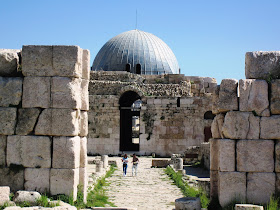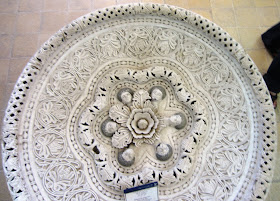Citadel: a fortress that provides security and protection for a city.
The citadel is on top of the center peak. At its base is a narrow valley, and on the other side of the valley are a series of additional steep hills on which the city is built.That means that the 360 degree view from the top of the citadel is of hills that are almost as steep and high as the citadel itself.
In nearly every direction we could see these unimaginative, desert-colored, matchbox-style buildings:How can a place with so much natural beauty build such ugly neighborhoods?
On a distant hillside we could see the Raghadan Flagpole, which is planted at the compound used as the royal residence by King Abdullah I and King Hussein, although not by the current king. At 416 feet tall, it was the tallest free-standing flagpole in the world when it was erected in 2003. The flag is 200 x 100 feet, or about two-thirds the size of a football field. These days the Raghadan Flagpole is only the 7th tallest flagpole in the world, far behind Saudi Arabia's 558-foot-tall flagpole in Jeddah.
Between these ancient stone walls and that modern city lies a deep crevasse:

This photo is the best I have of the rocky cliffs that drop from the top of the citadel to the valley:
From one vantage point we could see the huge amphitheater cut into the hillside, visible near the center of the photo below:
I looked for a video showing a concert in this venue and ran across this one of Zade Dirani, a young pianist whose music we have enjoyed in the past. In fact, we own one of his CDs. I had no idea he was Jordanian! Anyway, the video has some excellent shots of the theater. I'll bet it is a blast to go to a concert there, much like the amphitheater near the Acropolis in Athens where the New Age musician Yanni has performed:
I have to give another shout-out for our guide Isam, who rejoined us for this, our last day in Jordan. (The rest of our large group had flown out the previous night.) He has a deep knowledge of the history and culture of Jordan. I can't imagine a better guide. He started our exploration of the Citadel at these stelae that give the dates of the various civilizations that have inhabited this area since the Neolithic period in 5500 BC. After the Neolithic Period came the Chalcolithic Period, Bronze Age, Iron Age, Persian Era, Hellenistic Period, Nabataean Period (Petra), Romans (during which time it was called Philadelphia), Byzantines . . .
The list of civilizations reads like a Who's Who of World History.
The Citadel is an open air museum, pieces of various civilizations and time periods scattered over the hill like sprinkles on a cupcake. Turn to the right at it's the Byzantine Era; turn to the left and it's the Umayyads. Sometimes the cultures are mixed together in a way that makes them indistinguishable from one another. Often the later groups dismantled structures built by earlier groups and used the parts to build their own edifices. Talk about a melting pot!
There are several distinct structures Isam wanted to make sure we saw, beginning with the water system. Where I grew up, we are so proud that our ancestors developed irrigation systems that would harness the abundant mountain water for our crops. In contrast, the Citadel had no such source of water, not even a tiny natural spring, so the people had to depend on the careful collection and storage of every drop of water that fell from the sky. Sophisticated underground stone channels transported and recycled the water. Like everything else, the water system has been rebuilt many times by the various civilizations that occupied this space. This gargantuan cistern dates to 730 AD in the Umayyad Period:
Our next stop was the Temple of Hercules. Although nothing like what we had seen in Jerash a few days earlier, it was still very impressive:
It was larger than anything ever constructed in Rome. The columns are 33 feet tall, and the structure measures 101 x 85 feet. The sacred area surrounding the temple is 400 x 236 feet, much bigger than a football field.

Built in 161-166 AD, about the same time as the amphitheater discussed earlier, it once looked like this model:
 |
| Photo from Wikipedia |
Want to know why archaeologists and historians named this the Temple of Hercules? This sign tells why:
Only two pieces of that symbol of strength survived, and they lie broken on the ground:
Everywhere we went on this trip had beautiful flowers. Ah, the benefits of spring travel!
Our next stop was a Byzantine Church, c. 550 AD. The builders of this church "borrowed" some of the Corinthian capitals decorated with acanthus leaves from the Temple of Hercules:
Behind the church sits the Ummayad Palace, built around 730 AD and one of the dominating structures on the Citadel. I love this view of it with the skyscrapers of Amman--the one section of the 360 degree view that was unique--in the background:
The inside feels like a Medieval castle--stone walls with some of the decorative carving still visible, dim lighting, and lofty ceilings:
Looking back towards the door:
It's unusual to see the interior structure of a dome sans plaster. This modern recreation is beautiful in its unadorned symmetry:
I love the views from windows. Look carefully and you'll see an airplane through the first window. The second window could be looking out at the blue sky of any of the last dozen or more centuries:
Information on site showed what the left window above looked like prior to the restoration process:
A reconstructed wall represents what was once the palace mosque:
"We're walking, we're walking . . . ":
Many residential units have been excavated at the Citadel. These housed those involved in government activities:
A distant mosque appears much closer than it actually is:
The Jordan Archaeological Museum, which was built in 1951, is also on the Citadel. It contains artifacts from sites all over Jordan, dating from prehistoric times to the 15th century:
 |
| Photo from here |
I loved the faces in this reduced-scale plaster copy of a dome from a bath in an Ummayad palace in Jericho (661-750 AD):
Imagine carving this out of stone (and without power tools):
Here are two more exquisite carvings, but I think these are stone originals:
This little skeleton is from the Chalcolithic Period, or 4500-3300 BC.
The sign propped against the pink pillow reads: "The burial of infants in jars was a common custom in Mesopotamia, Egypt, and Palestine. The jar was generally placed under the living room floor, possibly to keep the child within the family circle."
We enjoyed the people-watching almost as much as we enjoyed the archaeological sites:
If only these walls, in varying conditions and from various epochs of history, could tell us what they've seen and heard:























































Note that one side of the city is all the ugly yellow buildings and the other side is relatively clean, white buildings. This paled in comparison to Jerash, but I truly loved Amman.
ReplyDeleteIt was amazing to see these cities built around the ancient ruins, as if they were everyday scenery. It would be like building my house next to a dinosaur dig. Such an interesting place with so much history!
ReplyDeleteYou and Bob really packed in a lot on this trip, but I can see you winding down, catching the last of the ruins. So much to see in that area of the world!
ReplyDelete